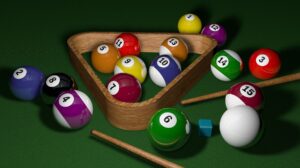The game of billiards, also called pool, has been around for centuries. Though royals were its original aficionados, the popularity of the game quickly filtered down to commoners. Shakespeare even mentions billiards in his famous work, Antony and Cleopatra.
Today, all types of people play pool across the globe! What began as lawn entertainment similar to croquet evolved into an indoor table game, using wooden poles called cues to maneuver balls into the proper positions.
The concept is simple. Sink your balls into the pockets or holes around the table before your opponent does. But there are more nuanced rules to the game for a player who wants to get serious and specific regulations concerning setup before gameplay begins.
Read on to learn standard regulations so you too can enjoy playing pool.
The Basics
Eight-ball pool is the most common version of the game, so that’s what we’ll cover here. (Later on, we’ll touch on other types, such as nine-ball.) A standard game intends for two players to face each other in a single match, though tournaments are common.
SETUP
Before you begin, ensure each player has a pool cue of appropriate length. They may want to use chalk to improve the friction of their pool cue.
The first task is setting up, or “racking,” the table. Using the provided triangular rack, place the balls inside it following these rules:
- 1-ball sits in the apex (single top row, by itself)
- 8-ball goes in the middle (third row down from the top)
- A striped ball sits in one bottom corner, and a solid in the other (numbers don’t matter)
- Place the other balls at random throughout the rack.
GAMEPLAY
In billiards, the goal is to sink, or pot, all the balls of either the striped or solid variety. After this, the player must also sink the 8-ball, ending the game and declaring them the winner.
The first action is distributing the balls around the table to initiate gameplay, called “breaking.” Lift the rack from around the balls and set it aside. Place the white ball behind the serving line, which rests one-quarter of the length from one of the table’s long ends. The first player to take their turn shoots the white ball towards the set of balls to scatter them. Whoever sinks the first ball, claims that type (solids or stripes) as their color and the game progresses accordingly.
Players alternate turns, during which they can stand anywhere along the edge of the table to take a shot at any non-white ball of their choice. If they sink a ball into a pocket, they take another shot. If they fail to hit any balls or scratch, the shot goes to the opposing player, who continues to take shots until they miss.
If the player who chose solids sinks all the solid balls into the pockets, then the 8-ball wins the game. Likewise, the player playing stripes must sink all of their balls plus the 8-ball to be declared the winner. The catch here is that they must verbally state which pocket they intend to put the 8-ball in before sinking it. Otherwise, they forfeit their turn giving the other player a chance to catch up.
The nuances of billiards have to do with angles, stance, aim, and directional shots. There is a technique called “bridging” in which the player creates a resting place for the pool cue by arching their hand and fingers. This opens the door to trick shots and other more advanced play.
Common pool strategies include identifying patterns on the table. Seasoned players use both clusters and space to their advantage. Choosing balls to hit based on how they will either disperse or block an opponent’s next shot.
Other minor rules are listed on the World Pool-Billiard Association’s website regarding dress code, referees, coaching, and foul play. Slight differences occur if following the American Poolplayers Association’s rules, mostly having to do with breaking protocol and verbal regulations (such as the omission of calling your shots).

Courtesy Rules
Besides the directives of the game, there are customary rules of etiquette when playing pool that all players should follow.
For example, it is rude to sit or lean on the table. Make sure to create space for gameplay without disturbing the position of the balls, as even slight movement can adjust their resting position and change the outcome of the game. When you take your shot, don’t lay your body over the table to do it – instead, find a different angle from which you can reach.
It’s also commonly understood that players should allow a wide path for their challengers to walk around the table and best position themselves to shoot. Even in a small bar or playing space, keep away from another player’s cue so as not to crowd them.
As with any sport, it’s paramount to show respect and good sportsmanship to the other players. Hassling, yelling, and causing a general nuisance is unwelcome in any billiards room.
POOL SHARK
A pool shark is a negative term for a player who cons others to achieve winning. This could be by cheating at the game, swindling them out of money, or other forms of hustling.p

Variations
Though eight-ball is the classic way to play, there are deviations from this setup that can create more fun at the billiards table.
NINE-BALL
Here, the objective is to sink all the balls in numerical order, with the winner being whoever sinks the nine-ball first. There isn’t as much leeway to recover from bad hits like as in the eight-ball strategy. For this reason, nine-ball is considered to be more difficult.
MORE THAN 2 PLAYERS
Though the typical game involves two players competing against each other, other versions bring in teams. The popular game of cutthroat uses three players and divides up the balls based on their numbers – 1-5, 6-10, and 11-15.
SETUP VARIATIONS
Rack the balls in numerical order or according to a pattern of stripes and solids.

